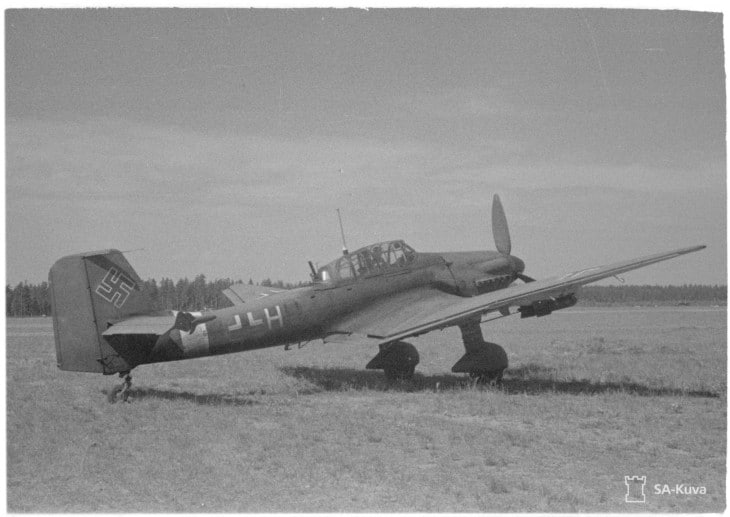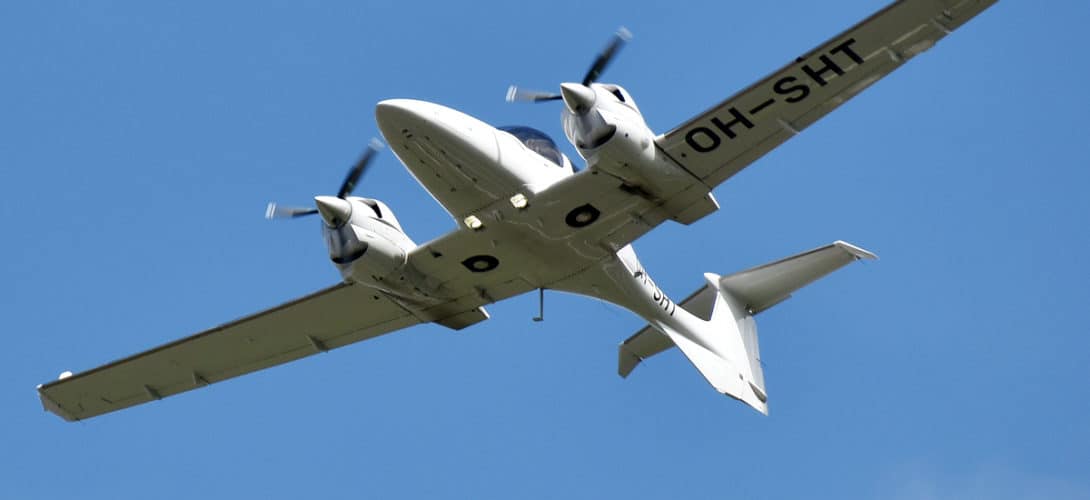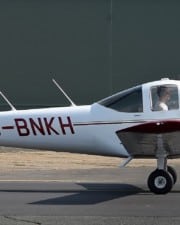There is a revolution occurring in modern light aircraft that you might not be aware of. More and more planes are being designed that use diesel engines. What is the benefit of diesel engines in aircraft, and will they become more mainstream?
Diesel engines operate much more efficiently. Plus, they are more forgiving of the types of fuel that they can operate on. For light aircraft, diesels can be tuned to run on jet fuel, which is more widely available and less expensive than traditional aviation-grade gasoline.
Several new diesel engines have been certified in the last few years, and several airplanes have been designed as diesel-powered platforms. The best known and most common diesel aircraft today is the sleek and sexy Diamond DA-42 Twin Star. Let’s take a look at these engines and what makes them tick.
Diesel Engines in Light Aircraft
Most small propeller-driven airplanes have traditionally used gasoline engines. They run on avgas, a special derivative fuel that is high-octane and still contains a lead additive. In the 1970s, lead was outlawed in the US and most countries as an automobile fuel additive. An exception has been made to allow for its use in planes.
Why does avgas still contain lead?
Plane engines operate at higher temperatures than cars since they are used at almost full power for most of their lives. Lubrication is a significant problem on these engines, and the lead in the fuel is a power lubrication additive. Engine manufacturers have been unable to produce a reliable, high-power unleaded aircraft engine.
Many older lower-power engines, less than 150 horsepower, can successfully operate on unleaded automotive fuel. While this is possible, in practice, it seldom happens. Most planes are kept at airports, and most airports sell plane fuel, not auto fuel. So while these planes can operate on less expensive and cleaner “mogas” unleaded fuel, the pilots don’t have any access to it.

There are also quality issues with using automotive fuel. Fuel handling and cleaning is a serious business in aviation, where any amount of water in the fuel is considered a serious safety risk. Engines cannot run with even the slightest bit of water in the fuel, so FBOs regularly take samples to ensure their fuel has no water in it.
The same strict standards are not applied at your local car gas station. If water gets into autogas and causes a problem, the worst-case scenario is that the car breaks down and needs a tow. Things are a little less critical when you don’t leave the ground.
The Problem with 100LL Avgas
100LL (100 octane low-lead) is the gasoline fuel that most piston aircraft burn. Since the ban on leaded fuels in the 1970s, 100LL is the only aviation-grade gasoline around. Engines certified to run on older leaded gas will operate with few problems on 100LL.
The demand for leaded fuel has declined. After all, only small aircraft are using it. It has been replaced by unleaded fuel in nearly every other industry, and the biggest consumers of aircraft fuels, the turboprops and turbine-powered set, burn jet fuel. As demand has waned, manufacturers have reduced supply and raised prices.
Environmental protection laws have gotten stricter; even a low-lead version is becoming even less acceptable. The additive, tetraethyllead, is toxic and a severe heavy pollutant. Fuel spilled on the ground at airports runs off into the groundwater. Planes will expel much of the lead through the exhaust pipe and into the atmosphere with every engine stroke.
So what is the future aviation alternative to 100LL? While some manufacturers have doubled-down on their commitment to make an unleaded fuel source work, others have taken a different tactic. What if a reciprocating engine were made that could run on jet fuel?
Can Planes Run on Diesel?
Chemically speaking, jet fuel is very similar to diesel fuel. Diesel engines, in general, are very forgiving and can run on many types of fuel oil. Some people modify their diesel cars and trucks to run on used fry oil from fast-food restaurants!
The advantage of burning jet fuel is that it’s widely available at airports, and since it’s in constant demand, there is a plentiful supply. It’s even available in remote places around the world, just as long as jets fly there.
Advantages of Diesel Aircraft Engines
Besides burning jet fuel, a widely available fuel source, diesels have other advantages. The first is their efficiency—diesels use a greater percentage of their fuel source’s available power. Diesel and jet fuel are more energy-dense anyway, so the result is an engine that operates exceptionally efficiently.
Jet-A is also less explosive and, therefore, safer than avgas.
Aircraft Diesel Engines Disadvantages
For their benefits, diesels present many challenges for aircraft operators. For one thing, they are heavier for the amount of horsepower they produce. A heavier engine means less payload for the plane—less weight in passengers and baggage for civilian planes, or fewer bombs or weapons for a warplane.
To top it off, jet fuel is heavier than avgas. Gasoline weighs approximately six pounds per gallon, whereas jet fuel weighs between seven and eight pounds per gallon. That extra pound doesn’t sound like much, but when you start looking at a plane that holds 100 gallons or more, it’s a substantial decrease in the plane’s payload capacity.
History of Diesel Engines in Aircraft
You may be surprised to know that the first successful flight of a diesel-powered aircraft occurred in 1928. Diesel is a very old technology, after all. The first compression ignition engine was created and named after Rudolf Diesel in 1894. The plane was a Stinson SM-1DX Detroiter, and it spurred a flurry of activity in the design of diesel aircraft for airplane service.
In the 1930s, one of the best-known diesel was the Junkers Jumo series of two-stroke diesels. These engines had a unique design with two pistons in each cylinder. They were large and flat, and Junkers used them on the Junkers Ju-86P reconnaissance aircraft and the six-engine Blohm & Voss BV222 Wiking flying boat. They also become common on airships of the time. The Germans had hoped to use this high-powered engine on fighters, but it proved too unreliable at the high power settings needed for combat.

The Germans weren’t the only people using diesel tech in aircraft during WWII. The Soviets, English, and Americans also had various diesels in use at the time.
Diesels for aircraft fell out of favor for many decades. Gasoline internal combustion engines had gotten reliable and powerful, and jet engines took over most of the work of pushing large aircraft. Manufacturers considered diesels too heavy, with the negatives outweighing the positives. It wasn’t until the early 2000s that the technology was revived.
The first new motor to be certified was built by Thielert Engines of Germany. They made two engines, the Centurion 1.7 and Centurion 2.0. Both were approved to run on either Jet A or diesel. The engines were aimed directly at older airplanes with avgas-burning motors. The Centurion powerplant was a direct replacement for the ubiquitous Lycoming O-360 motors found in Cessnas and Pipers.

Thielert attracted quite a bit of attention. Diamond Aircraft of Austria began using their motors in their DA-40 Star, and they built the DA-42 Twin Star from the ground up as the first new-generation diesel aircraft. The US military also uses Thielert diesels on some of their drones.
The Thielert Centurion engines are inline four-cylinder engines based on Mercedez TDI automobile engines. As such, they were designed to operate at much higher RPMs than can be used to spin a propeller, so they are equipped with reduction gearboxes and other airplane-friendly technologies.

The story of Thielert engines, though, takes a disappointing turn. Due to poor management, the company went bankrupt just as their product was showing great potential. Other shortcomings in management appeared, too. Shortcuts had been taken in the engine design, resulting in outrageously high maintenance costs for owners. Their bankruptcy also made warranty claims impossible, further worsening the company’s reputation and recovery.
Regardless, the company did prove the concept. Diamond stood behind the idea of using diesels and began the development of their own model. The Austro engine was designed to continue use on their fleet and is now used on the DA-42NG and the new DA-62.
The Thielert engine designs have been passed along to several companies that continue to improve them. For a while, the new company was called Centurion, but it was bought by Technify Motors, a subsidiary of Continental Motors. Continental has also designed and certified their own diesel power plant, and there are several other companies with designs in the works.
How Do Diesel Engines Operate?
Diesel engines are commonly referred to as compression ignition engines. Most gasoline engines use spark plugs to ignite the fuel-air mixture, but diesels accomplish this without spark plugs. To understand how they work, it’s easiest to discuss each of the four cycles of a combustion engine—intake, compression, combustion, and exhaust.
Intake
The intake stroke of a diesel brings in air to the cylinder. As the piston travels down, a suction is formed, drawing in air through the air filter. This is different from gasoline engines, which draw in both air and fuel on their intake strokes. Diesels need a large volume of air to operate, so it’s very common for diesels to be super or turbocharged.
Compression
As the piston travels up the cylinder, the valves are closed, and the air is compressed to very high pressures. Cylinder compression is much higher in diesels, and as the air reaches very high pressures, it also gets very hot.
Combustion
Once the cylinder has reached the top of its stroke, fuel is injected into the hot compressed air. Because of the heat already involved, that fuel spontaneously combusts, forcing the piston down for the power stroke. To be injected, the fuel must be of the same pressure as the air, so diesels have to use high-pressure fuel pumps to pressurize the fuel.
The high-pressure fuel pump is a complicated and expensive item. Some simpler mechanical engines have a metering system that divides the fuel up and sends it off to each injector, not unlike a gasoline fuel-injection system. Newer electronic technologies enable the fuel to be pressurized into a common rail system, with the injectors opening via electronic control. This system is very efficient but also very complex and expensive.
Another complication in design comes from all of that pressurized fuel. The engine will use only a tiny fraction of the fuel supplied to the injectors, so the rest must be returned to the (wing) fuel tanks. Since the fuel was pressurized and hot, it may need to be cooled first. A fuel cooler is common on aircraft diesel engine installations.
One last consideration for ensuring that the fuel combusts when it should is the ambient temperatures. Once the engine is running, its own heat will provide more than enough to combust the fuel. But when first starting the motor on a cold day, it might take quite a bit of cranking to get it hot enough to run. To solve this problem, manufacturers install electric heaters in the cylinder heads known as glow plugs. These plugs run off the battery until the engine is running and then shut off once the engine is warm enough to run without their help.
Exhaust
As the piston returns up the cylinder, the exhaust valve opens, and the waste gases are expelled. As mentioned above, most diesels are super or turbocharged. On a turbocharged system, the exhaust gasses spin a turbine that compresses in the incoming air. That provides denser, compressed air for the combustion cycle, and it ensures that the engine manifold pressures don’t change much as altitude increases.
If manufacturers want even more power from the engine, they may opt to install an intercooler. These are simple heat exchangers installed between the turbocharger and the engine air intake that cool that dense air down for even better performance.
Two Strokes vs. Four-Stroke Diesels
Like gasoline motors, it is possible to make a two-stroke version that accomplishes the same goals. The early diesels that found their success before and during World War II were two-strokes because they were simpler to build and design.
Two-stroke motors bring in air and fuel through open ports in the cylinder walls, removing the complexities of valves and camshafts. They are cleverly designed so that the piston’s range of travel controls what port is open when. The downward power stroke also brings in fuel and air, while the upward stroke expels the exhaust.
Two-stroke engines have fallen out of favor in the 21st century because they traditionally produce more air pollution. But if that problem can be solved, two-strokes have a significant advantage for aircraft. By being so much simpler, they are also much lighter and more competitive with gasoline options.
FADEC Technology
With their complexity and the need for electronic control, diesel engines are the perfect candidates for FADEC control systems. FADEC stands for Full-Authority Digital Engine Control. It’s a system commonly found on new turbine and turboprop planes to make engine operations simpler.
The operating principle behind a FADEC engine is to make the pilot’s job easier. Engine operations are usually somewhat formulaic, so a computer can control most of those functions. FADEC engines are set with a power or thrust lever, usually based on the percentage of engine output desired. Gone are the standard throttle, prop, and mixture controls.
When the pilot sets the desired power, the computer then determines how best to achieve it. It controls things like the throttle, propeller speed, fuel injectors, and turbocharger wastegate on a diesel engine.
The system will also monitor all aspects of the engine and alert the pilot of anything out of the ordinary. The system can tie things like fuel pressure, oil pressure, oil temperature, manifold pressure, and cylinder head temperature into one central alert system.

Most manufacturers call the engine computer that does all of this the ECU, or Engine Control Unit. It’s a critical piece of equipment because if it failed, the engine would stop. To ensure flawless operation, two completely separate ECUs are installed per engine. The system runs both computers in parallel, always checking to see if anything is different. If there’s an error, the pilot can choose one to operate from and troubleshoot the problem.
Since many of the FADEC components are electrically controlled, having backup power sources is extremely important. The standard aircraft electrical system of a reserve/starting battery charged by one alternator is insufficient and lacks redundancy. Some manufacturers install emergency battery packs just for the FADEC ECUs in case all other power is lost. Having two charging alternators on board is another good policy.
Why Are Diesel Engines Not Used (More) in Aircraft?
The first two decades of the 21st century have seen something of a renaissance for diesel engines in aircraft, but these engines are still cutting edge technology. The idea is proven. In Europe, a majority of new automobiles sold have similar TDI diesel engines. The trick is optimizing these engines for use in the air by shaving off excess weight while maximizing reliability.
More companies are designing and certifying diesels to replace old gasoline engines. At the same time, more aircraft makers and making new and innovative designs with these new power plants. Diamond continues to install their Austro diesels in the DA-40 and 42 and their new DA-50 and DA-62. Continental-powered versions of the Piper Archer and the Tecnam P2010 are now available.
Many plane makers have dipped their toes in the diesel fuel, so to speak, but few have found commercial success. It remains a burgeoning technology in light aircraft, which is an industry heavily rooted in reliable, traditional, and mechanical technologies. Cessna and Mooney have both abandoned their sales plans for TDI planes, so only the future will tell if diesel engines are the way of the future or just a technological footnote in history.
Related Posts













